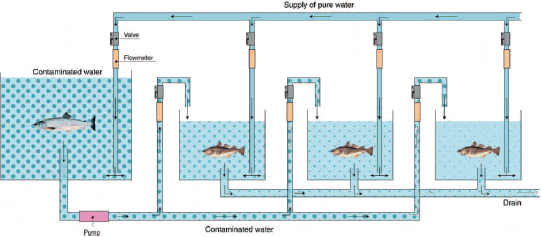Due to a growing fish farming industry in the coastal area, it may be necessary to co-localise new farms with marine fish species close to existing salmon farms. Several fish pathogenic-bacteria and viruses cause diseases in various fish species, and it is therefore important to investigate whether these diseases can be transferred between neighbouring fish farms.
In the Fish Health Laboratory at Tromsø Aquaculture Research Station, waterborne transfer of diseases between various fish species or other marine organisms can be studied in a specially designed tank system. The system consists of four tanks: In the main tank, a certain fish species is actively infected with a fish-pathogenic bacteria or virus of interest, after which various amounts of infected water are continuously transferred to three peripheral tanks containing other species. So far, the system has been tested by transferring classical vibriosis (serotype O2a) from salmon to cod.
First, we will study the transfer of bacterial and viral diseases between cod, halibut and salmon. Even though the salmon are vaccinated against classical vibriosis, typical furunculosis, coldwater vibriosis, winter ulcer and infectious pancreatic necrosis (IPN), outbreaks of winter ulcer and IPN still occur. This could be a threat to cod or halibut in neighbouring farms that are currently not vaccinated against potential diseases.
Also, outbreaks of, for example, atypical furunculosis or viral nervous necrosis (VNN) in cod and halibut could be a threat to neighbouring farms with salmon. The project is financially supported by Innovation Norway.

July 2006

